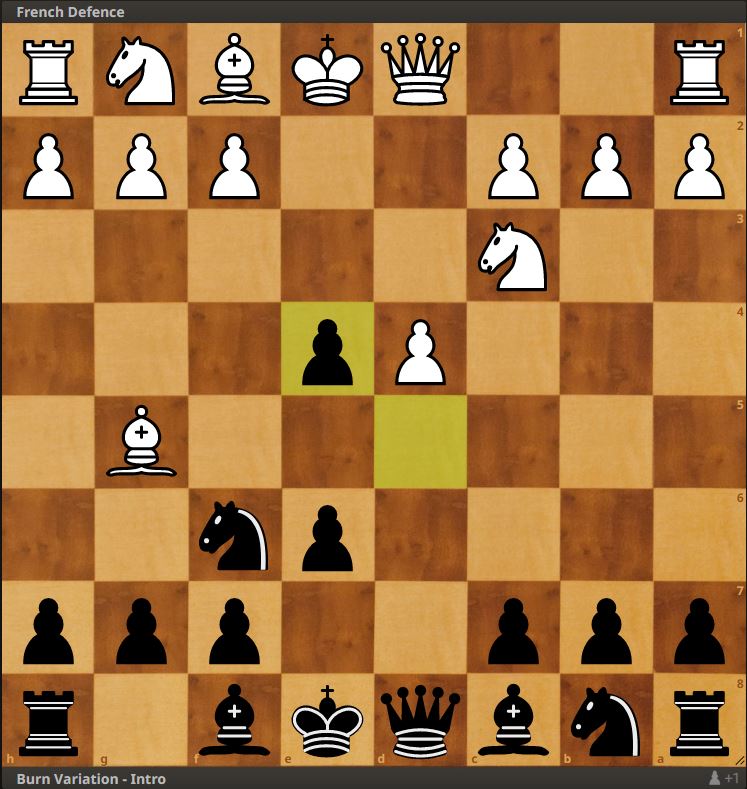This article is part of a series of articles covering different Opening Variations. You can find the complete list of Openings/Variations covered on the following link.
Introduction
After covering the Alekhine-Chatard variation of the French Defence, today, we are going to continue our explorations of the 4.Bg5 Classical French and analyze arguably the best reply available to Black, the move 4…dxe4 leading to the so-called Burn Variation of the French Defence.
Burn Variation Of The French Defence
Overview and main ideas
The main variation analyzed in this post will be the variation of the French Defence that arises after the moves 1.e4 e6 2.d4 d5 3. Nc3 Nf6 4.Bg5 dxe4

Even though as beginners we are taught not to release the tension in the center prematurely as it activates the opponent’s pieces and gives them more space, Black’s argument is that drawing the knight to e4 will create some opportunities to challenge it and potentially exchange it. And since we have less space, exchanging the pieces is very much in our favour.
This variation is similar to the Rubinstein Variation that arises after 1.e4 e6 2.d4 d5 3. Nc3/Nd2 dxe4:

,but here Black tries to make an argument that the version with the bishop on g5 is even more favorable because Black will play Be7 and seek to exchange the bishops, too. On the other hand, the bishop does create a potential pin/pressure on the f6 knight. As usual, when it comes to modern chess openings – there are two sides to the same coin.
In any case, the Burn variation continues 5.Nxe4 and now Black has a choice. The “pure” Burn move is 5…Be7, while it is also possible to play the move 5…Nbd7 and transpose to a variation of the Rubinstein defence where White has developed the bishop to g5. In this article, the focus will be on the former, while the latter will be analyzed in greater detail in a separate article devoted to the Rubinstein Variation.
Black plays with f5
After 5…Be7, the knight on e4 is under attack and White’s best way of dealing with the pressure on it is to capture the attacking knight on f6. Experience shows that the move 6. Nxf6 is a bit toothless (and you can check the analysis to see why) and the only challenging move is 6.Bxf6 when Black’s best and most common reply involves capturing with the g-pawn and reaching the starting point of the Burn Variation after 7.Nf3:

At first glance, it is not 100% obvious how Black should develop and where should the king castle. But actually, the quintessential question here is – should Black play the move f5 to kick the knight from e4? There are both pros and cons to this move – on one hand, it does remove the knight from the center and gains some share of space. But on the other hand, the knight can immediately jump to c3 and start preparing ideas connected with the d5 breakthrough. As the analysis and variations demonstrate, this idea has a lot of potential and can lead to some very fascinating lines:
Black plays without f5
As we have just seen, the variation where Black chases the knight away to c3 is not without its dangers due to the tricky knight sacrifice. Therefore, the question is – should Black bother kicking the knight away? What if Black plays without the f5 move and just continues with the development?
It is a legitimate way of playing, but it also has a certain drawback. Namely, with the knight on e4, there is the option of jumping to c5 – especially if Black goes for the standard a6-b5 setups and weakens this square in the process. I am far from the expert of this line, but it seems to me this is the case of going from frying pan to the fire and that Black should decide to play f5 sooner rather than the later. The analysis provided below can partly demonstrate why:
Free Lichess Study devoted to the Burn Variation
Youtube video devoted to the Burn Variation
Free Download of the Burn Variation .pgn file

